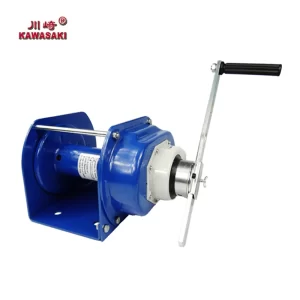Hand winches are versatile tools used to lift or pull heavy loads manually, with applications ranging from vehicle recovery and boat towing to lifting construction materials and moving heavy equipment. However, the potential for injury or strain, if used improperly, underscores the need to adopt safe and labor-saving practices when operating these devices. This comprehensive guide explores how to use a hand winch safely and efficiently, covering aspects such as proper winch selection, understanding load limits, safe operating techniques, regular maintenance, and ways to reduce physical effort.
#### 1. Understanding Hand Winch Basics
A hand winch consists of a spool (drum) around which a cable, rope, or strap is wound. The device uses a gear mechanism to increase mechanical advantage, allowing a person to pull or lift a heavier load than they could with just their body strength. Hand winches are typically classified into two types:
**Manual gear winches:** The operator turns a handle to wind the cable and move the load.
**Brake winches:** These have a braking mechanism that prevents the load from unwinding when the handle is released, providing enhanced control and safety.
##### Key Components of a Hand Winch:
– **Drum (or spool):** The cylindrical component around which the cable or strap winds.
– **Handle:** The lever used to rotate the drum.
– **Gears:** These reduce the effort required by increasing mechanical advantage.
– **Cable/Strap:** The line attached to the load. It can be steel cable, synthetic rope, or a webbed strap.
– **Hook:** The point where the winch cable connects to the load.
– **Mounting base:** This secures the winch to a fixed or mobile platform.
– **Ratchet (in some models):** A ratchet prevents the handle from spinning backward and releasing tension.
#### 2. Selecting the Right Hand Winch
Before using a hand winch, choosing the appropriate tool for the task is crucial to ensure both safety and efficiency. Selecting the right winch depends on several factors:
##### a. Load Capacity
One of the most important considerations is the load capacity, usually expressed in pounds (lbs) or kilograms (kg). Overloading a winch beyond its rated capacity can lead to cable breakage, gear failure, or handle snapping, resulting in injuries or equipment damage. To avoid these risks, choose a winch with a capacity that exceeds the weight of the load by at least 50%.
##### b. Type of Load
The type of load can influence the kind of winch and cable material you select. For example:
– **Steel cable winches** are strong and durable, making them ideal for heavy industrial loads but are prone to rust and can fray.
– **Synthetic rope or straps** are lighter and more flexible, reducing the risk of injury from recoil if the line snaps, but they are more susceptible to abrasion and UV damage.
##### c. Winching Environment
Consider the environmental conditions when selecting a hand winch:
– **Corrosion resistance:** If the winch will be used in marine or outdoor environments, choose a model with corrosion-resistant materials (e.g., galvanized steel or stainless steel components).
– **Ease of portability:** For mobile applications like vehicle recovery, a lightweight, portable winch is preferable. For stationary tasks, a heavy-duty model with secure mounting points is more appropriate.
##### d. Gear Ratio
Hand winches come with different gear ratios, which determine the effort required to lift or pull a load. A higher gear ratio means less force is needed to move the load, but the process will take more time. A lower gear ratio requires more effort but operates more quickly.
#### 3. Preparing for Winching
Before you start using a hand winch, it’s critical to prepare properly to ensure safety and reduce the physical effort required. Here are some key preparatory steps:
##### a. Inspect the Winch
Before every use, inspect the winch for any visible signs of damage or wear. Check for:
– **Frayed cables or ropes.**
– **Corroded or damaged parts.**
– **Loose or broken components (gears, hooks, handles, etc.).**
Replace any damaged components before operating the winch to avoid accidents.
##### b. Secure the Winch
Ensure that the winch is properly mounted on a stable surface, whether it is bolted to a frame, vehicle, or solid structure. An unstable or improperly mounted winch can shift under load, leading to accidents or equipment failure.
##### c. Select Appropriate Anchor Points
When pulling or lifting a load, make sure the anchor point (the object you attach the winch to) is strong enough to withstand the forces involved. Weak or unstable anchor points can lead to a loss of control, damage to the load, or injury.
##### d. Attach the Winch to the Load Correctly
– Ensure that the hook is securely fastened to the load, and the connection is made through a suitable attachment point, such as a D-ring or shackle.
– Use appropriate rigging accessories (e.g., slings, chains, pulleys) to distribute the load evenly and reduce the strain on any single point.
#### 4. Safe Operating Techniques
Safety during winching operations is paramount to avoid injury, property damage, or equipment failure. Here are some important safe-operating guidelines:
##### a. Wear Protective Gear
Always wear personal protective equipment (PPE) such as gloves, safety goggles, and sturdy footwear when operating a hand winch. Gloves are particularly important to prevent injuries from handling sharp or frayed cables.
##### b. Use Proper Body Mechanics
Winching can be physically demanding, and using improper body mechanics can lead to fatigue or injury. To minimize strain:
– Stand in a balanced, stable position.
– Use your legs and core muscles, rather than just your arms, when operating the winch handle.
– Avoid sudden or jerky movements.
##### c. Maintain a Safe Distance
Maintain a safe distance from the winch and load, particularly if using a steel cable. Cables can snap under tension, and if they do, they may recoil with dangerous force. Synthetic straps are less likely to recoil as violently, but caution should still be exercised.
##### d. Use a Winch Damper
In case of cable failure, a winch damper (a heavy blanket or jacket) draped over the cable can reduce the severity of recoil. If a steel cable snaps, the damper absorbs some of the energy and reduces the risk of injury.
##### e. Operate the Winch Slowly and Steadily
– Avoid rushing the winching process. Apply slow, steady force to the handle to keep the load under control.
– If the winch has a ratchet mechanism, engage it between turns to prevent the handle from spinning backward.
– Ensure the load moves smoothly without sudden jerks, which could put undue stress on the cable or gears.
#### 5. Reducing Physical Effort
Although hand winches are designed to provide mechanical advantage, winching can still be physically taxing. Here are some strategies to reduce the labor involved:
##### a. Utilize Pulleys and Snatch Blocks
Using a pulley or snatch block can effectively double the pulling power of a winch while halving the force required by the operator. A snatch block changes the direction of the pull, allowing for more efficient use of the winch and distributing the load across multiple anchor points.
##### b. Choose a Higher Gear Ratio
A winch with a higher gear ratio requires less physical effort to operate, though it moves the load more slowly. For tasks that demand a high degree of control and reduced manual labor, a high-ratio winch can be an excellent choice.
##### c. Take Breaks and Rotate Operators
If you’re working on a long winching job, take regular breaks to avoid fatigue. If possible, rotate operators to prevent any one person from becoming too tired, which can lead to mistakes or injury.
##### d. Leverage Technology
For labor-intensive tasks, consider using a powered winch or a hybrid winch system that incorporates a hand winch with motor assistance. While these systems are more expensive, they can significantly reduce physical effort and improve efficiency.
#### 6. Regular Maintenance
Routine maintenance is essential to ensure that your hand winch remains safe and functional. Well-maintained winches not only reduce the risk of failure but also operate more smoothly, requiring less effort from the operator.
##### a. Lubricate Gears and Moving Parts
Lubricate the winch gears, handle, and other moving parts regularly to reduce friction and wear. This will make the winch easier to operate and extend its lifespan. Be sure to use the correct type of lubricant as recommended by the manufacturer.
##### b. Inspect and Replace Cables
Steel cables can fray over time, developing sharp edges or losing tensile strength. Synthetic ropes can also suffer from UV degradation or abrasion. Regularly inspect the cable or strap, and replace it immediately if you notice any damage.
##### c. Tighten Loose Components
Ensure that all nuts, bolts, and other fasteners are tight and secure. Loose components can cause the winch to become unstable during operation.
##### d. Clean After Use
If you’ve used the winch in a dirty, muddy, or salty environment (such as in marine applications), clean it thoroughly after use. Remove any dirt or debris from the cable and moving parts, and apply anti-corrosion treatments if necessary.
#### 7. Special Considerations for Different Applications
The way you use a hand winch may vary depending on the specific task or industry. Here are a few examples:
##### a. Vehicle Recovery
When using a hand winch for vehicle recovery, such as pulling a stuck car out of mud or snow:
– Ensure that the vehicle’s wheels are pointed in the right direction and reduce resistance by clearing obstacles around the tires.
– Use a snatch block to increase the

